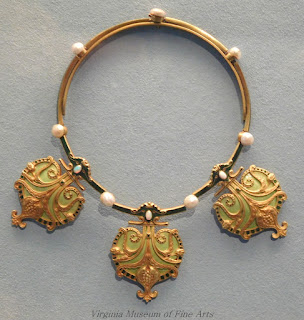Breakfast Links are served - our weekly round-up of fav links to other web sites, articles, blogs, and images via Twitter.
• Ownership and imprints: famous hands and famous gloves.
• Even a genius has to sell himself: the remarkable resume of Leonardo daVinci.
• Wealthy boys from Eton who were accustomed to getting their own way: The Eton College Riot, 1818.
• "I don't know whether to kiss you or spank you": a half-century of fear of an unspanked woman.
• Image: 17thc blocks for printing playing cards.
• The golden age of the classic high heel: Ferragamo, Vivier, and the stiletto.
• The extraordinary life of Marianne North, Victorian explorer, naturalist, and painter.
• A history of virility, and why it's different (and maybe better than) mere manliness.
• Blue men, the bean-nighe, and a brownie: more mythical creatures of Scotland.
• Image: Postcard of American tourists in Europe, 1910.
• Why the colors you see in an art museum can't be replicated today.
• Why there's nothing vanilla about vanilla.
• An early 19thc church in Manhattan's Henry Street still retains its slave galleries.
• Painstaking portraits of 19thc dermatology patients.
• Image: Central dome of the 1889 Paris World's Fair Gallery of Machines - the world's largest interior space at the time.
• Could the Broadway smash Hamilton keep a woman's face off the $10 bill?
• The secret history of the Civil War photo at the center of the black confederate myth.
• Egyptian blue, the oldest known artificial pigment.
• Only a year after the San Francisco earthquake in 1906, Mrs. Irwin wears an "earthquake costume" to a party.
• A tale of two 18thc patriots from Salem, MA.
• For an editor in 1800, the best way to document a brutal local murder was to publish an epic poem about the crime.
• Image: Good luck using this 19thc tax calculator.
• Long (but interesting!) read: conversations and chimney-pieces: the role of the hearth in 18thc British portraiture.
• Watch 65 of Charlie Chaplin's films free online.
• Presidential inaugurations: national unity and partisan poking.
• Is Longfellow's famous poem about Paul Revere's ride really a call to 19thc abolitionists?
Hungry for more? Follow us on Twitter @2nerdyhistgirls for fresh updates daily.
Above: At Breakfast by Laurits Andersen Ring. Private collection.
Laws Concerning Women in 1th-Century Georgia
1 year ago




































 One of us --
One of us -- 


